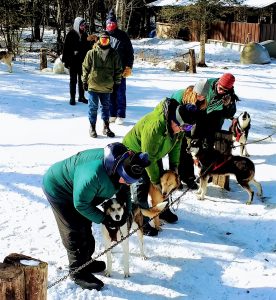The VOBS dogs are on my mind. I’m looking at photos of Studio/E’s recent dogsled “hook-up.” Studio/E is a membership program designed to help leaders launch and navigate ideas. Recently, their folks joined us up at Homeplace for a weekend of adventure, testing limits and exploring new territory for growth. These “hook-up” pics document the process of readying dogs for a run– working with each individual dog and coordinating with fellow students to assemble the team and attach them to the sled. The photos show the sometimes comical logistical choreography of creating three teams at once, but they also quietly reveal something pretty powerful.
In shot after shot, you see students in the throes of deep concentration and focus, bent to the task of tending to the dogs correctly and compassionately. The students are clearly in service of the dogs. The dogs are clearly masters of patience and tolerance. Looking at dog body language, I see each animal not as resigned or bending to human will, but as choosing to be present, making themselves available– teaching! Individual dogs track students with their gaze, make eye contact with the camera and maintain an awareness of the big picture. I was a teacher for years and in the VOBS dogs I see the stance of awareness and readiness I saw in my teaching team on the best days.
It was a privilege to simply document the experience. Observation opened up a wealth of understanding about the potential of our collaboration with Studio/E. It is my hunch that the dog team teaches us about our personal and professional teams, showing us how to facilitate and embrace learning– to provide just the right kind of support– or as Nate Garvis, Co-founder of Studio/E, explains so well, “teeing up the right kind of rigor.” We are delighted to republish Nate’s reflection on “playing to the dog’s strengths” here:
MAKING THINGS HARD IN THE RIGHT WAY
A couple of weekends ago we trekked up to the northern reaches of Minnesota with a hearty team of Studio/E explorers and spent some time with the amazing souls at the Voyageur Outward Bound School. We were situated next to the one million preserved acres of the Boundary Waters Canoe Area that borders the two million preserved acres called Quetico on the Canadian side. In other words, we were in midst of a whole lot of nature and not a lot else. There was enough snow to play on and the temperatures were sub-sub-zero. It was glorious.
Amongst the challenges facing us over the weekend was the steep learning curve of mushing sled dogs across the winding forested trails and the glassy expanses of iced-over lakes. The dogs were magnificent beasts; each one of bursting with energy and distinct personalities. The sleds were sturdy, the Outward Bound guides patient and wise and the guest mushers were, well … there was a learning curve.
Being at the back of a dog sled is a busy place. One moment you’re hanging on for dear life, the next you’re trying to keep the sled upright. Then you’re pushing the sled up a hill in the aim of giving the dogs an assist, and next you’re shouting a command to the four legged professionals up front. And all the while you’re being told to ride the brakes.
Ride the brakes? That didn’t sound right.
It certainly didn’t sound fair to the dogs. But here’s what we learned: sled dogs have specific capabilities and talents. Some are built for speed and some are built to haul heavy loads. Our team was comprised of dogs bred for the latter. Therefore, when we thought we were doing the “kind” thing of not braking, lightening the load and letting them run, we were actually playing to their weakness.
Left to our own ignorance we would have left these dogs ragged and at some point they would have just quit and laid down. No, the right thing to do in this case was to ride the brakes, making the sled feel heavier and thus playing to the dogs’ strengths.
It got us wondering about how that applies in our everyday lives and how we work with others. Surely, there is great benefit to pushing through rigors, for nothing great was ever accomplished by just coasting by.
But as we present the hard work ahead to ourselves and those we partner with, are we teeing up the right kind of rigor?
Thankfully, our wonderful Outward Bound teachers were students of the dogs, literate in their ways and experienced in pushing the right work upon them. So the question we’re posing to ourselves is this: are we literate in the ways and strengths of those around us, and are we making things hard in the right way for them? Are we pushing boundaries in a way that is reckless, not risky?”
Many thanks to Nate, Tom and Studio E leaders for helping us “tee up the right kind of rigor.”
To put your group on course for challenge and adventure, reach out to Outreach (me!):
marlais.brand@vobs.org













